A Hot Blob Eastward of New Zealand in December 2019
Abstract
1. Introduction
2. Data and Methods
3. Results
3.1. Features of the Hot Blob Eastward of New Zealand in December 2019
3.2. Mixed-Layer Heat Budget of the Hot Blob Event in November and December 2019
3.3. Comparison of the Historical Strongest Hot Blob in December 2001
4. Discussion
Supplementary Materials
Author Contributions
Funding
Acknowledgments
Conflicts of Interest
References
- Schär, C.; Vidale, P.L.; Lüthi, D.; Frei, C.; Häberli, C.; Liniger, M.A.; Appenzeller, C. The role of increasing temperature variability in European summer heatwaves. Nature 2004, 427, 332–336. [Google Scholar] [PubMed]
- Sparnocchia, S.; Schiano, M.E.; Picco, P.; Bozzano, R.; Cappelletti, A. The anomalous warming of summer 2003 in the surface layer of the Central Ligurian Sea (Western Mediterranean). Ann. Geophys. 2006, 24, 443–452. [Google Scholar]
- Barriopedro, D.; Fischer, E.M.; Luterbacher, J.; Trigo, R.M.; García-Herrera, R. The hot summer of 2010: Redrawing the temperature record map of Europe. Science 2011, 332, 220–224. [Google Scholar] [PubMed]
- Karl, T.R.; Cleason, B.E.; Menne, M.J.; McMahon, J.R.; Heim, R.R.; Brewer, M.J.; Kunkel, K.E.; Arndt, D.S.; Privette, J.L.; Bates, J.J.; et al. U.S. temperatures and drought: Recent anomalies and trends. Eos Trans. Am. Geophys. Union 2012, 93, 473–474. [Google Scholar]
- Hobday, A.J.; Alexander, L.V.; Perkins, S.E.; Smale, D.A.; Straub, S.C.; Oliver, E.C.J.; Benthuysen, J.A.; Burrows, M.T.; Donat, M.G.; Feng, M.; et al. A hierarchical approach to defining marine heatwaves. Prog. Oceanogr. 2016, 141, 227–238. [Google Scholar]
- Oliver, E.C.J.; Donat, M.G.; Burrows, M.T.; Moore, P.J.; Smale, D.A.; Alexander, L.V.; Benthuysen, J.A.; Feng, M.; Sen Gupta, A.; Hobday, A.J.; et al. Longer and more frequent marine heatwaves over the past century. Nat. Commun. 2018, 9, 1324. [Google Scholar]
- Hot Blob: Vast Patch of Warm Water off New Zealand Coast Puzzles Scientists. Available online: https://www.theguardian.com/world/2019/dec/27/hot-blob-vast-and-unusual-patch-of-warm-water-off-new-zealand-coast-puzzles-scientists (accessed on 19 November 2020).
- Salinger, M.J.; Renwick, J.; Behrens, E.; Mullan, A.B.; Diamond, H.J.; Sirguey, P.; Smith, R.O.; Trought, M.C.T.; Alexander, L.V.; Cullen, N.J.; et al. The unprecedented coupled ocean-atmosphere summer heatwave in the New Zealand region 2017/18: Drivers, mechanisms and impacts. Environ. Res. Lett. 2019, 14, 044023. [Google Scholar]
- Salinger, M.J.; Diamond, H.J.; Behrens, E.; Fernandez, D.; Fitzharris, B.B.; Herold, N.; Johnstone, P.; Kerckhoffs, H.; Mullan, A.B.; Parker, A.K.; et al. Unparalleled coupled ocean-atmosphere summer heatwaves in the New Zealand region: Drivers, mechanisms and impacts. Clim. Chang. 2020, 162, 485–506. [Google Scholar]
- Perkins-Kirkpatrick, S.E.; White, C.J.; Alexander, L.V.; Argüeso, D.; Boschat, G.; Cowan, T.; Evans, J.P.; Ekström, M.; Oliver, E.C.J.; Phatak, A.; et al. Natural hazards in Australia: Heatwaves. Clim. Chang. 2016, 139, 101–114. [Google Scholar]
- Pearce, A.; Feng, M. The rise and fall of the marine heatwave off Western Australia during the summer of 2010/2011. J. Mar. Syst. 2013, 111, 139–156. [Google Scholar]
- Wernberg, T.; Smale, D.A.; Tuya, F.; Thomsen, M.S.; Langlois, T.J.; Bettignies, D.T.; Rousseaux, C.S. An extreme climatic event alters marine ecosystem structure in a global biodiversity hotspot. Nat. Clim. Chang. 2013, 3, 78–82. [Google Scholar]
- Bond, N.A.; Cronin, M.F.; Freeland, H.; Mantua, N. Causes and impacts of the 2014 warm anomaly in the NE Pacific. Geophys. Res. Lett. 2015, 42, 3414–3420. [Google Scholar]
- Di Lorenzo, E.; Mantua, N. Multi-year persistence of the 2014/15 North Pacific marine heatwave. Nat. Clim. Chang. 2016, 6, 1042–1047. [Google Scholar]
- Joh, Y.; Di Lorenzo, E. Increasing coupling between NPGO and PDO leads to prolonged marine heatwaves in the Northeast Pacific. Geophys. Res. Lett. 2017, 44, 11663–11671. [Google Scholar]
- Unusual Species in Alaska Waters Indicate Parts of Pacific Warming Dramatically. Available online: http://www.adn.com/article/20140914/unusual-species-alaska-waters-indicate-parts-pacific-warming-dramatically (accessed on 20 November 2020).
- Whitney, F.A. Anomalous winter winds decrease 2014 transition zone productivity in the NE Pacific. Geophys. Res. Lett. 2015, 42, 428–431. [Google Scholar]
- Walsh, J.E.; Bieniek, P.A.; Brettschneider, B.; Euskirchen, E.S.; Lader, R.; Thoman, R.L. The exceptionally warm winter of 2015/16 in Alaska. J. Clim. 2017, 30, 2069–2088. [Google Scholar]
- Hartmann, D.L. Pacific sea surface temperature and the winter of 2014. Geophys. Res. Lett. 2015, 42, 1894–1902. [Google Scholar]
- Cavole, L.M.; Demko, A.M.; Diner, R.E.; Giddings, A.; Koester, I.; Pagniello, C.M.L.S.; Paulsen, M.-L.; Ramirez-Valdez, A.; Schwenck, S.M.; Yen, N.K.; et al. Biological Impacts of the 2013–2015 Warm-Water Anomaly in the Northeast Pacific: Winners, Losers, and the Future. Oceanography 2016, 29, 273–285. [Google Scholar]
- Yang, Q.; Cokelet, E.D.; Stabeno, P.J.; Li, L.B.; Hollowed, A.B.; Palsson, W.A.; Bond, N.A.; Barbeaux, S.J. How “The Blob” affected groundfish distributions in the Gulf of Alaska. Fish. Oceanogr. 2019, 28, 434–453. [Google Scholar]
- Jones, T.; Parrish, J.K.; Peterson, W.T.; Bjorkstedt, E.P.; Bond, N.A.; Ballance, L.T.; Bowes, V.; Hipfner, J.M.; Burgess, H.K.; Dolliver, J.E.; et al. Massive mortality of a planktivorous seabird in response to a marine heatwave. Geophys. Res. Lett. 2018, 45, 3193–3202. [Google Scholar]
- McCabe, R.M.; Hickey, B.M.; Kudela, R.M.; Lefebvre, K.A.; Adams, N.G.; Bill, B.D.; Gulland, F.M.D.; Thomson, R.E.; Cochlan, W.P.; Trainer, V.L. An unprecedented coastwide toxic algal bloom linked to anomalous ocean conditions. Geophys. Res. Lett. 2016, 43, 10366–10376. [Google Scholar] [PubMed]
- Seager, R.; Hoerling, M.; Schubert, S.; Wang, H.L.; Lyon, B.; Kumar, A.; Nakamura, J.; Henderson, N. Causes of the 2011–14 California drought. J. Clim. 2015, 28, 6997–7024. [Google Scholar]
- Tseng, Y.-H.; Ding, R.Q.; Huang, X.M. The warm Blob in the northeast Pacific—The bridge leading to the 2015/16 El Niño. Environ. Res. Lett. 2017, 12, 054019. [Google Scholar]
- Oliver, E.C.J.; Wotherspoon, S.J.; Chamberlain, M.A.; Holbrook, N.J. Projected Tasman Sea extremes in sea surface temperature through the 21st century. J. Clim. 2014, 27, 1980–1998. [Google Scholar]
- Oliver, E.C.J.; Benthuysen, J.A.; Bindoff, N.L.; Hobday, A.J.; Holbrook, N.J.; Mundy, C.N.; Perkins-Kirkpatrick, S.E. The unprecedented 2015/16 Tasman Sea marine heatwave. Nat. Commun. 2017, 8, 16101. [Google Scholar]
- Behrens, E.; Fernandez, D.; Sutton, P. Meridional oceanic heat transport influences marine heatwaves in the Tasman Sea on interannual to decadal timescales. Front. Mar. Sci. 2019, 6, 228. [Google Scholar]
- Kämpf, J.; Doubell, M.; Griffin, D.; Matthews, R.L.; Ward, T.M. Evidence of a large seasonal coastal upwelling system along the southern shelf of Australia. Geophys. Res. Lett. 2004, 31, 1–4. [Google Scholar]
- Roughan, M.; Middleton, J.H. On the east Australian current: Variability, encroachment, and upwelling. J. Geophys. Res. Oceans 2004, 109, 1978–2012. [Google Scholar]
- Olita, A.; Sorgente, R.; Natale, S.; Gaberšek, S.; Ribotti, A.; Bonanno, A.; Patti, B. Effects of the 2003 European heatwave on the Central Mediterranean Sea: Surface fluxes and the dynamical response. Ocean Sci. 2007, 3, 273–289. [Google Scholar]
- Kalnay, E.; Kanamitsu, M.; Kistler, R.; Collins, W.; Deaven, D.; Gandin, L.; Iredell, M.; Saha, S.; White, G.; Woollen, J.; et al. The NCEP/NCAR 40-year reanalysis project. Bull. Am. Meteorol. Soc. 1996, 77, 437–472. [Google Scholar]
- Kistler, R.; Kalnay, E.; Collins, W.; Saha, S.; White, G.; Woollen, J.; Chelliah, M.; Ebisuzaki, W.; Kanamitsu, M.; Kousky, V.; et al. The NCEP–NCAR 50-year reanalysis: Monthly means CD-ROM and documentation. Bull. Am. Meteorol. Soc. 2001, 82, 247–268. [Google Scholar]
- NCEP/NCAR Reanalysis 1: NOAA Physical Sciences Laboratory. Available online: http://www.esrl.noaa.gov/psd/data/gridded/data.ncep.reanalysis.html (accessed on 20 November 2020).
- Shi, J.; Qian, W. Connection between anomalous zonal activities of the South Asian High and Eurasian summer climate anomalies. J. Clim. 2016, 29, 8249–8267. [Google Scholar]
- Huang, B.; Thorne, P.W.; Banzon, V.F.; Boyer, T.; Chepurin, G.; Lawrimore, J.H.; Menne, M.J.; Smith, T.M.; Vose, R.S.; Zhang, H.M. Extended reconstructed sea surface temperature, version5 (ERSSTv5): Upgrades, validations, and intercomparisons. J. Clim. 2017, 30, 8179–8205. [Google Scholar]
- NOAA Extended Reconstructed SST V5: NOAA Physical Sciences Laboratory. Available online: https://psl.noaa.gov/data/gridded/data.noaa.ersst.v5.html (accessed on 20 November 2020).
- Reynolds, R.W.; Smith, T.M.; Liu, C.; Chelton, D.B.; Casey, K.S.; Schlax, M.G. Daily high-resolution-blended analyses for sea surface temperature. J. Clim. 2007, 20, 5473–5496. [Google Scholar]
- Saha, S.; Nadiga, S.; Thiaw, C.; Wang, J.; Wang, W.; Zhang, Q.; Van den Dool, H.M.; Pan, H.L.; Moorthi, S.; Behringer, D.; et al. The NCEP Climate Forecast System. J. Clim. 2006, 19, 3483–3517. [Google Scholar]
- NCEP Global Ocean Data Assimilation System (GODAS) at NOAA ESRL/PSL: NOAA Physical Sciences Laboratory. Available online: https://www.psl.noaa.gov/data/gridded/data.godas.html (accessed on 20 November 2020).
- Argo. Available online: https://argo.ucsd.edu/ (accessed on 20 November 2020).
- Cronin, M.F.; Pelland, N.A.; Emerson, S.R.; Crawford, W.R. Estimating diffusivity from the mixed layer heat and salt balances in the North Pacific. J. Geophys. Res. Oceans 2015, 120, 7346–7362. [Google Scholar]
- Schmeisser, L.; Bond, N.A.; Siedlecki, S.A.; Ackerman, T.P. The role of clouds and surface heat fluxes in the maintenance of the 2013–2016 Northeast Pacific marine heatwave. J. Geophys. Res. Atmos. 2019, 124, 10772–10783. [Google Scholar]
- Monterey, G.I.; Levitus, S. Climatological Cycle of Mixed Layer Depth in the World Ocean; US Government Printing Office, NOAA NESDIS: Washington, DC, USA, 1997; p. 5.
- NODC World Ocean Atlas 1994: NOAA Physical Sciences Laboratory. Available online: https://psl.noaa.gov/data/gridded/data.nodc.woa94.html (accessed on 20 November 2020).
- Hu, Z.Z.; Kumar, A.; Jha, B.; Zhu, J.; Huang, B. Persistence and predictions of the remarkable warm anomaly in the northeastern Pacific Ocean during 2014–16. J. Clim. 2017, 30, 689–702. [Google Scholar]
- Xie, S.P. A dynamic ocean–atmosphere model of the tropical Atlantic decadal variability. J. Clim. 1999, 12, 64–70. [Google Scholar]
- Chen, Y.; Hu, Q.; Yang, Y.; Qian, W. Anomaly based analysis of extreme heat waves in Eastern China during 1981–2013. Int. J. Climatol. 2017, 37, 509–523. [Google Scholar]
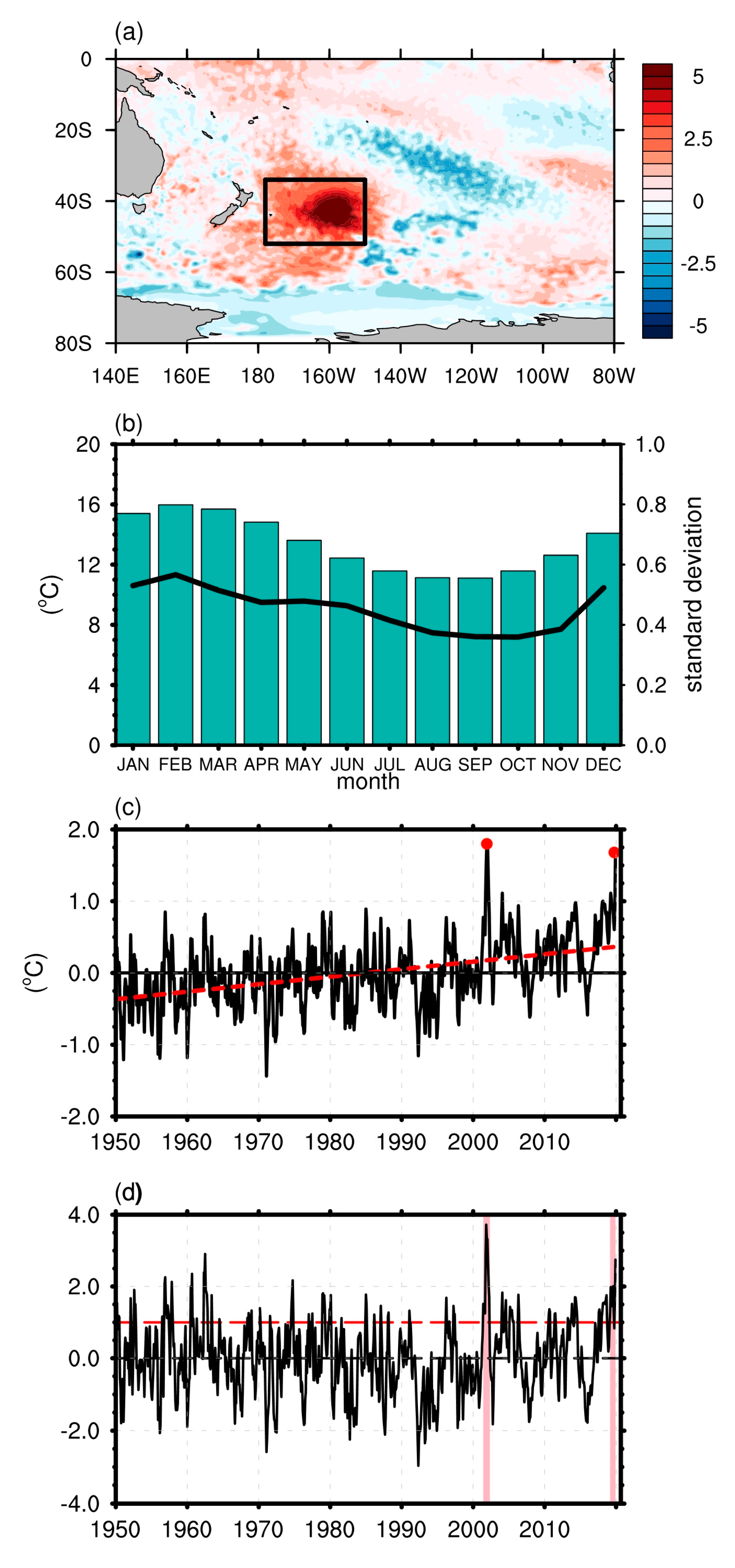
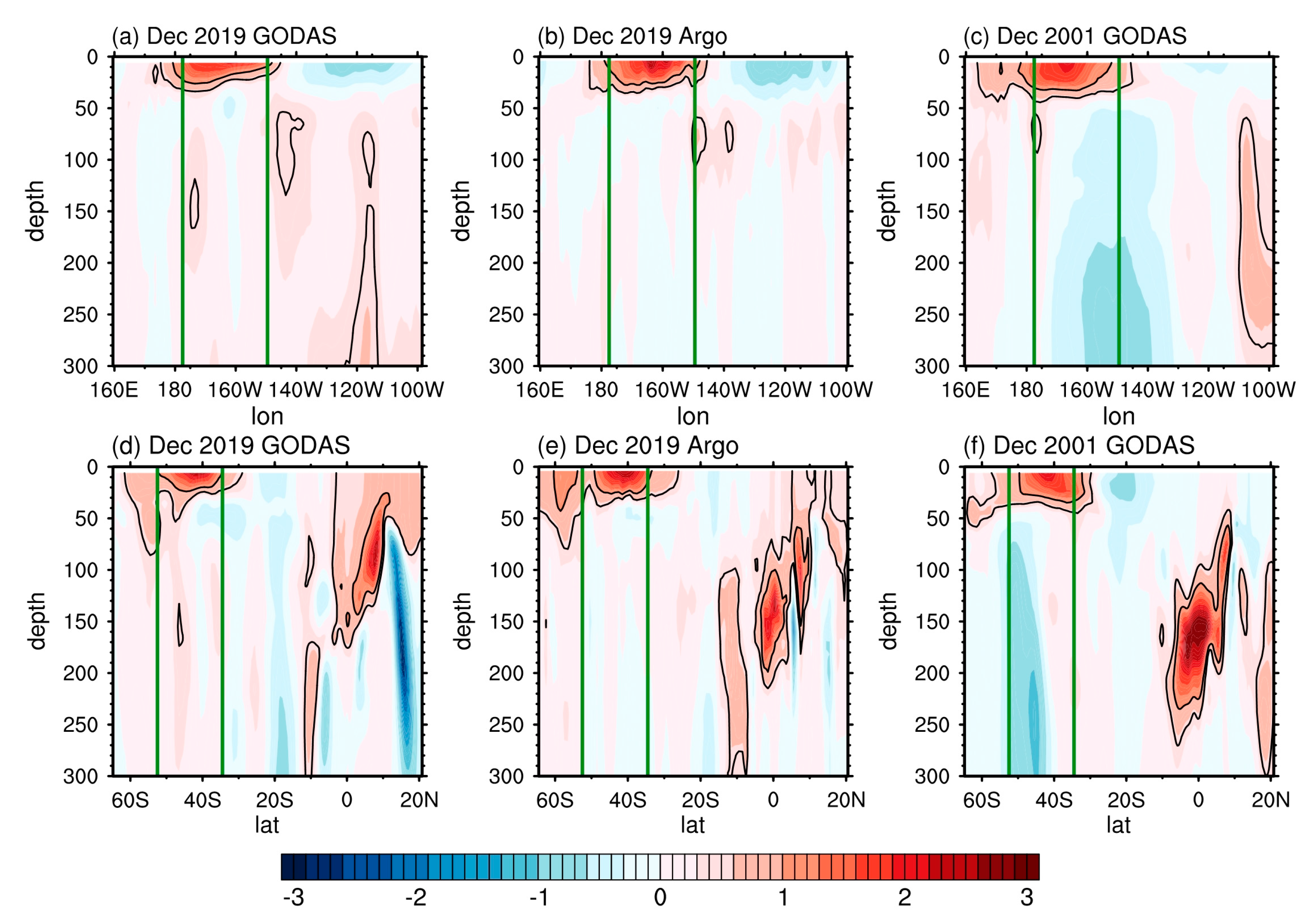


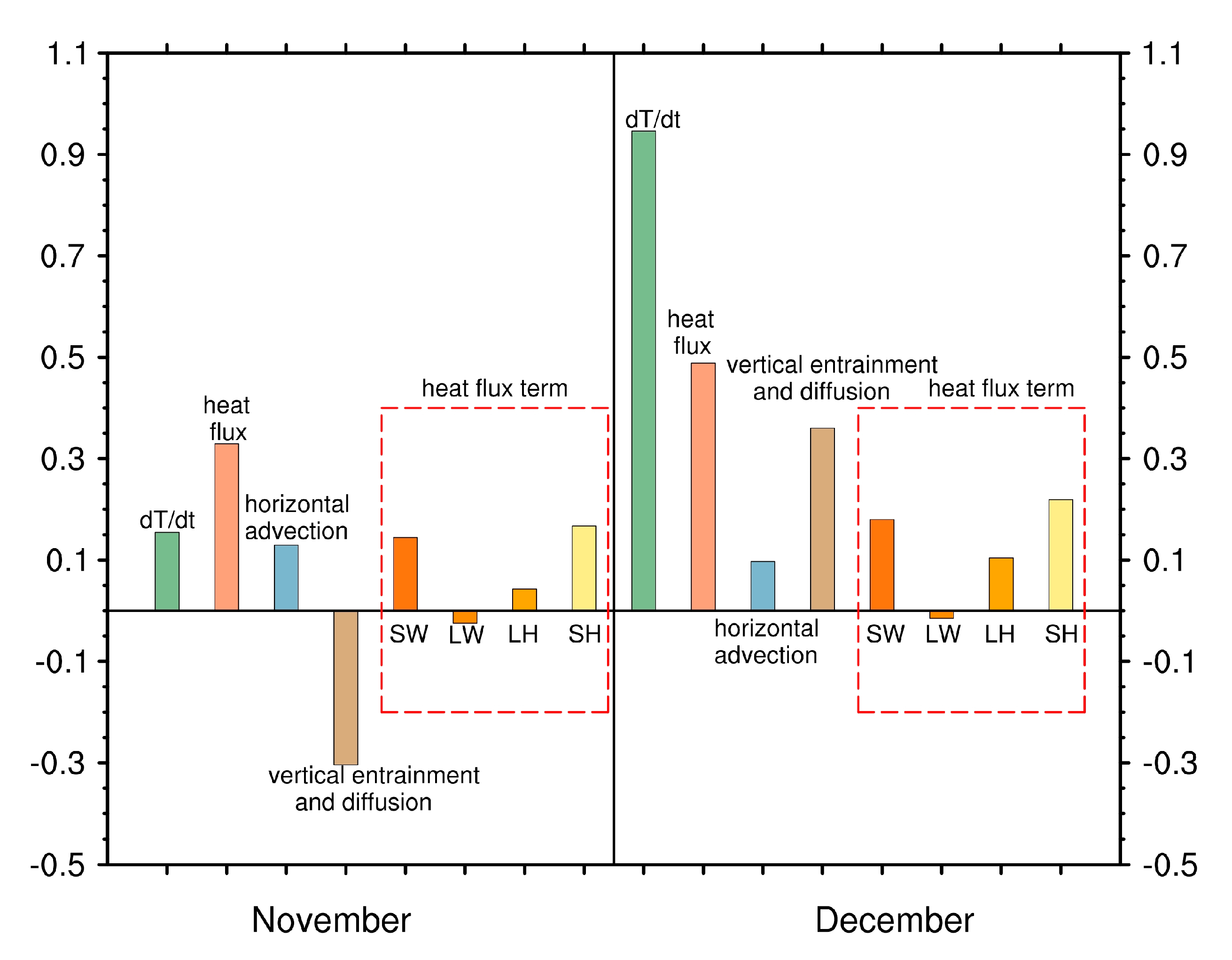
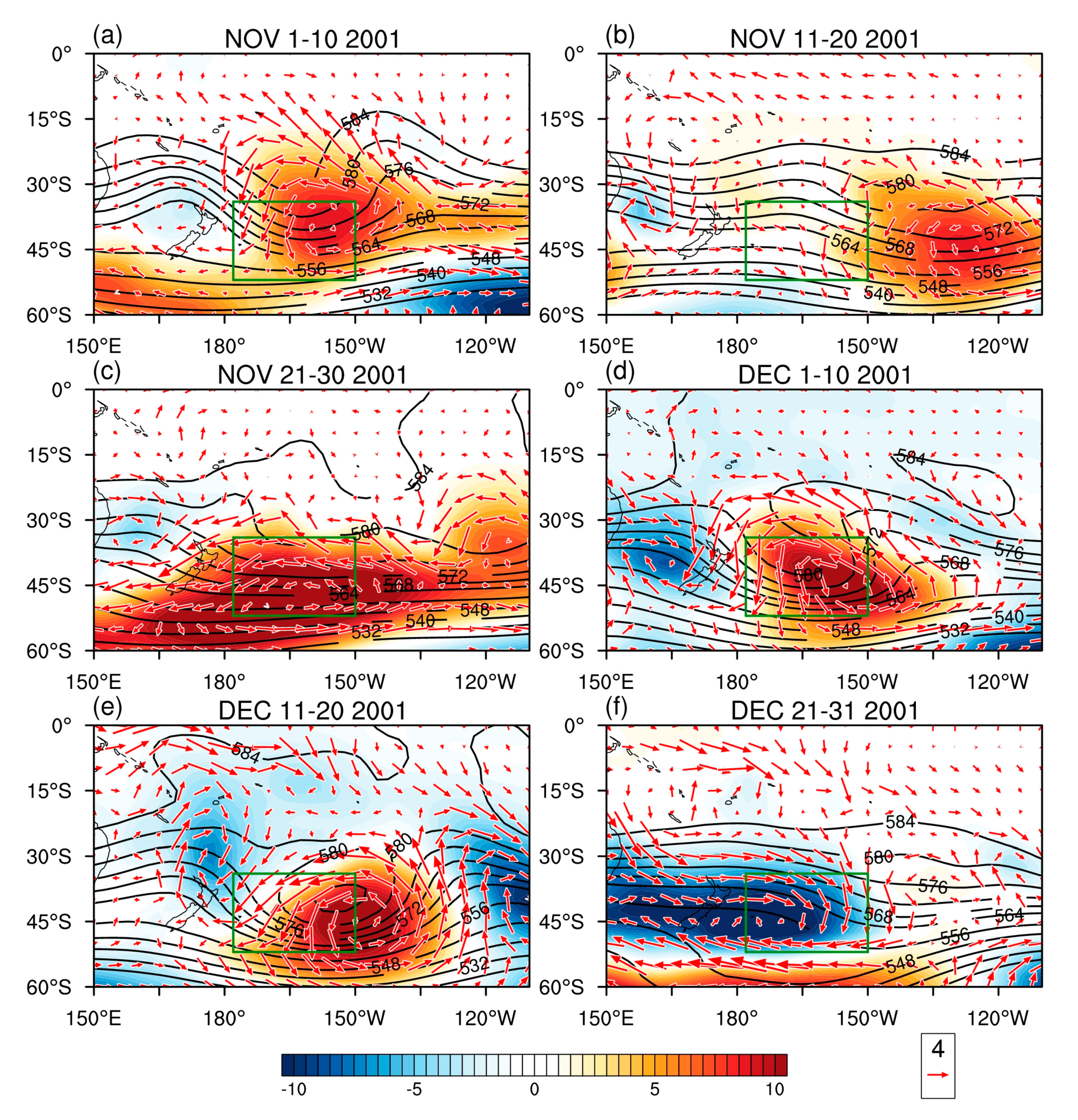
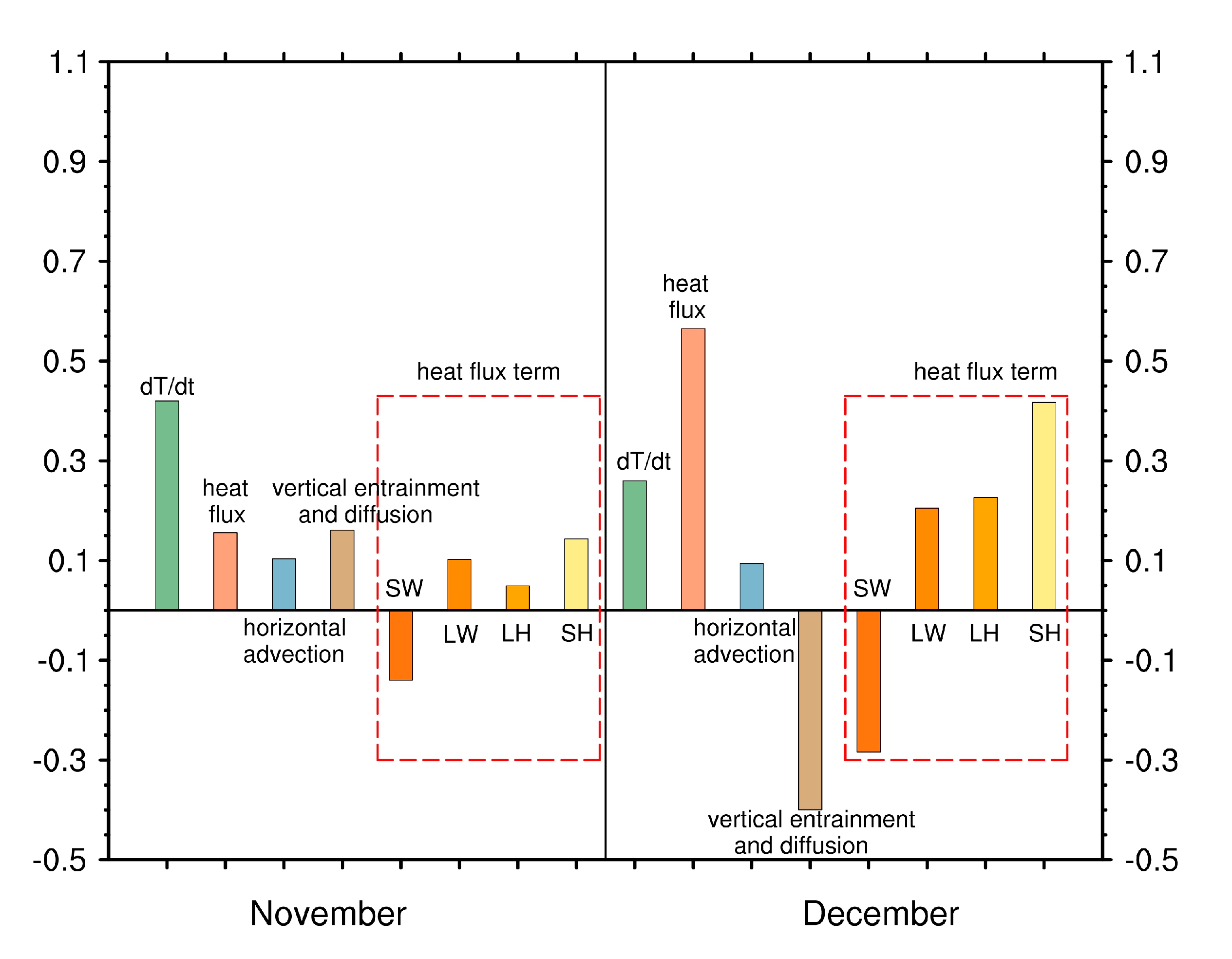
Publisher’s Note: MDPI stays neutral with regard to jurisdictional claims in published maps and institutional affiliations. |
© 2020 by the authors. Licensee MDPI, Basel, Switzerland. This article is an open access article distributed under the terms and conditions of the Creative Commons Attribution (CC BY) license (http://creativecommons.org/licenses/by/4.0/).
Share and Cite
Shi, J.; Chen, Z.; Ding, S.; Lu, Y. A Hot Blob Eastward of New Zealand in December 2019. Atmosphere 2020, 11, 1267. https://doi.org/10.3390/atmos11121267
Shi J, Chen Z, Ding S, Lu Y. A Hot Blob Eastward of New Zealand in December 2019. Atmosphere. 2020; 11(12):1267. https://doi.org/10.3390/atmos11121267
Chicago/Turabian StyleShi, Jian, Ziyan Chen, Saisai Ding, and Yiqun Lu. 2020. "A Hot Blob Eastward of New Zealand in December 2019" Atmosphere 11, no. 12: 1267. https://doi.org/10.3390/atmos11121267
APA StyleShi, J., Chen, Z., Ding, S., & Lu, Y. (2020). A Hot Blob Eastward of New Zealand in December 2019. Atmosphere, 11(12), 1267. https://doi.org/10.3390/atmos11121267




